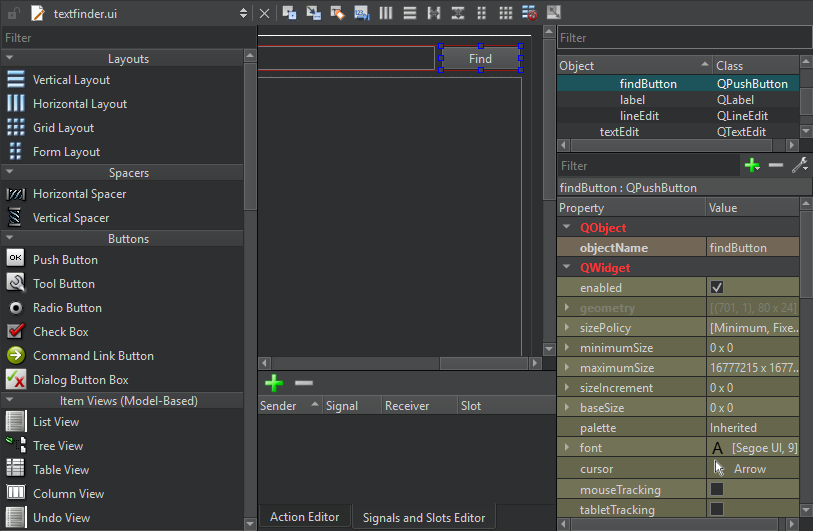Qt Designer Signals And Slots Tutorial
So I use QT Designer for the User Interface (UI), and convert this to python using “pyuic5” which generates a ui.py file
As this file gets overwritten every-time I make any changes to the UI, I would like to to have another .py file which has a signal/slot class and I can program there without any worries about copy/paste issues to/from the auto-generated ui.py file.
- Qt Designer Signals And Slots Tutorial Free
- Qt Creator Signals And Slots Tutorial
- Qt Designer Signals And Slots Tutorial For Beginners
- Qt Designer Signals And Slots Tutorials
But how do I:

Signals and slots are used for communication between objects. The signals and slots mechanism is a central feature of Qt. In GUI programming, when we change one widget, we often want another widget to be notified. More generally, we want objects of any kind to be able to communicate with one another. Run the application and see how it displays the window that you created in Qt Designer. Anything can be typed in the text field, but nothing happens. Let's make our application show a greeting message that includes the name entered in the text field. We need to define a slot and connect it to textChanged signal fired.

- generate a signal from another class in another file ?
- generate a slot from another class in another file ?
- write back into the ui.py class, ie writing some text in a text field.

It is no problem doing the above if I keep all the code in the ui.py file, but it does become a copy/paste issue and prone to me making simple errors.
Any suggestions or is this really not doable.
I have searched the net a lot but nothing has come up and everything I have tried doesn't work
Using QT Designer 5.7, pyuic5.8 and python 3.6x

Thanks

Quite a frequent problem when working with signals with slots in Qt5, according to my observations on the forum, is the connection of slots in the syntax on the pointers to signals having an overload of the signature. The same applies to slots that have an overload.
Let's take a test class that has overloaded signals.
Here there is a signal, with an overload of the signature. Connect this signal will also be to the slots that are declared in the Widget class, and which also have an overload of the signature.
Qt Designer Signals And Slots Tutorial Free
How it was in Qt4
Within Qt4, everything was solved quite simply by specifying the signature of the signal and the slot in the SIGNAL and SLOT macros.
How it became in Qt5
But in Qt5, when writing in the new syntax of signals and slots, there are some problems. Because you need to make the static_cast of the method signature.
By the way, the new syntax also allows you to connect signals to slots with a smaller signature, as it was in Qt4.
Qt Creator Signals And Slots Tutorial
Advantages of the new syntax
And now a stumbling block. Why use the new syntax of signals and slots? I still hear this question from time to time. Especially when people see such terrible castes of signatures.
Qt Designer Signals And Slots Tutorial For Beginners
- Therefore, I will list potential advantages:The ability to track errors in the connection of signals and slots at the compilation stage, rather than in the runtime
- Reducing compilation time by excluding macros from the code
- The ability to connect lambda functions, it's quite an important bun
- We protect ourselves from errors when we try to connect from the outside to a private slot. Yes!! Yes!! The SIGNAL and SLOT macros ignore the access levels of methods, violating OOP.
Qt Designer Signals And Slots Tutorials
In general, for me this is enough, but for you?